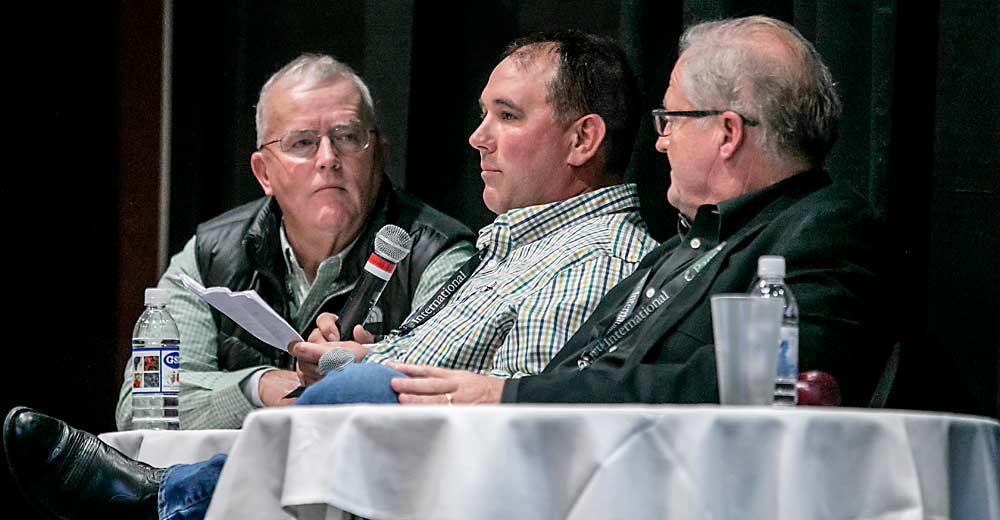Washington fruit producers now face tough decisions in their orchards, with rising costs and softening prices. That sometimes means pulling orchards and not replanting them.
“Our main strategy on replanting is don’t do it,” said Travis Allan, director of tree fruit at Allan Bros. Inc. in Naches, at the Washington State Tree Fruit Association Annual Meeting in Wenatchee in December.

Allan joined Tom Auvil of Orondo and Don Gibson, president of Mount Adams Fruit in Bingen, to discuss how their companies might react and the metrics they use to make those tough decisions at a time when it appears the industry may have overreached.
“We see these scenes that appear to be irrational exuberance,” Auvil said, echoing the title of the presentation. “You can see vast fields of new plantings of tree fruit.”
The trio’s panel talk was one of a few at the annual meeting that addressed signs of a cyclical downturn in the tree fruit industry, where fruit prices, even for premium varieties, have struggled to keep up with the surging labor costs.
Auvil, for example, said his farm’s cash operations have risen by 19 percent since 2014. Meanwhile, 2019 saw a 50 percent jump in volume of Honeycrisp over the previous crop, a spike that is driving down prices. Gala, Washington’s largest variety by volume, could be in bigger trouble, he said.
“We’re removing blocks and we’re not replanting,” Gibson said. “And I think that’s a reality that all of us have to get to.”
Gibson and Allan shared the process and metrics they use to determine what to keep, what to pull and when to replant.
Mount Adams
For apples, Mount Adams aims for blocks that produce 60 bins per acre, Gibson said. Blocks that perform below 45 or 50 bins come out, as do varieties that are difficult to market.
He only moves ahead with planting when he projects revenues above the cash cost over seven to 10 years or so, longer for pears.
Mount Adams has 230 blocks of fruit. The company continuously calculates a three-year-average gross revenue for each and ranks them. The ones toward the bottom are the first to get “attention,” which means either removed or analyzed for horticultural improvements or cost savings options. For apples — of which Mount Adams has few, compared to pears — target revenues are $10,500 per acre for varieties other than Honeycrisp.
For cherries, Mount Adams shoots for 10 tons per acre with new plantings, which the company can’t get with Bing, Gibson said. He suspects the variety is on its way out. He puts target costs at about $8,000 per acre, or 40 cents per pound. The company decides which blocks to pull by, again, ranking the revenue of each and focusing on the lowest. However, he uses a five-year average instead of three, to account for the extra variability in cherry crops.
Pears make up the bulk of Mount Adams’ acreage.
Gibson expects new blocks of pears to produce between 75 and 80 bins per acre. The company shoots for $10,500 in cash costs for a 90-acre orchard of older trees. On a large orchard, that drops to more like $8,000 due to spreading out costs. He would like to keep costs down to $200 per bin but can’t achieve that now, he said.
If a cannery block is yielding less than 50 bins per acre, he pulls the block.
Seeking higher returns, he plans to enter the club variety game with pears soon.
Allan Bros.
Allan Bros. usually replants apples at a pace to consistently keep 10 percent to 20 percent of its acreage in young, nonbearing trees, Allan said. Today, the company has all but stopped replanting. For removal, he targets blocks with low yields, those prone to fire blight and those with poor scion-rootstock combinations, he said.
An average target yield — the “sweet spot,” he called it — is 75 or 80 bins per acre. His high-density blocks sometimes can produce more than 100 but then may develop problems with fruit size and delayed maturity.
Though volumes of Gala are getting high overall, the company has been planting them in recent years, replacing older strains with new ones on more productive systems, he said. Gala has a good harvest window and stores well year-round, giving the integrated company’s warehouse a diversity of varieties.
Allan Bros. targets fruit when harvesting, too, picking only premium fruit that falls into a profitable size category, to drive up pack outs, he said. “We just don’t pick everything,” Allan said.
He estimates costs for a low-input, low-end block of, say, Granny Smith, at $10,500 per acre, including all inputs and labor. Galas range from $10,000 to $12,000 per acre — high because the company is trying to switch from hand thinning to chemical thinning. A high-end Honeycrisp block costs $12,500 per acre.
In cherries, Allan Bros. shoots for yields of 10 tons per acre on new plantings, with target costs of $8,000 to $12,000 per acre, and 40 to 60 cents per pound.
Lately, little cherry disease factors in to their decisions, too. “It’s like the Black Plague,” he said.
Allan had a tough time recommending what varieties to plant but stressed shooting for a high yield whatever people plant. For growers deciding to leave a field fallow, he recommended planting a cover crop, such as grains or grasses, to keep out weeds, then disc them into the ground for organic matter.
“It’s a tough time for the whole industry,” Allan said. “There’s not many winners out there.” •
—by Ross Courtney






Leave A Comment